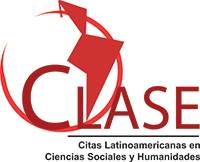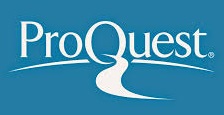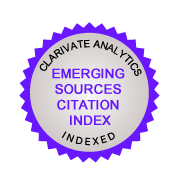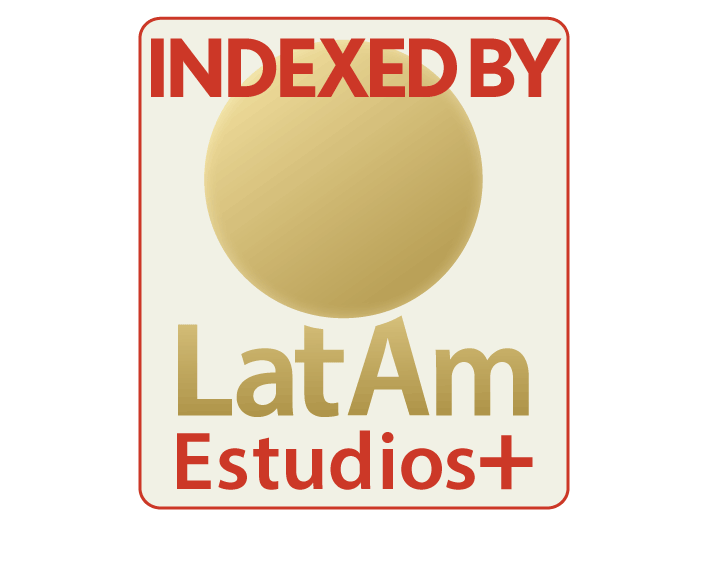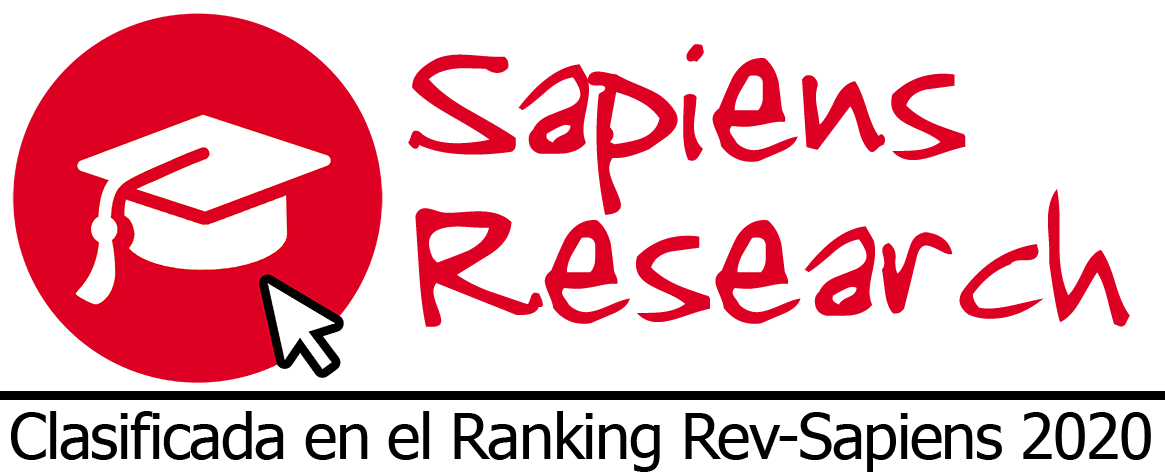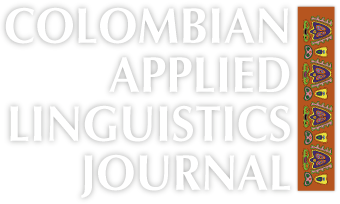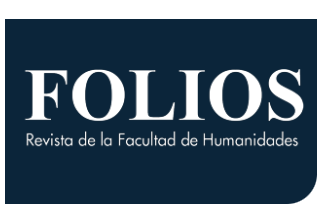Improving Pronunciation through the Use of Karaoke in an Adult English Class
Mejorando la pronunciación mediante el uso del karaoke en una clase de inglés para adultos
Keywords:
improving pronunciation, karaoke activities (en)mejoramiento de la pronunciación, actividades con karaoke (es)
Students often have difficulty and experience lots of problems with pronunciation in English. This article is based on a research project which intended to show how students can improve their pronunciation through the use of karaoke in their English class. By using karaoke, the teacher designs activities and involves students to improve their pronunciation. Students’ progress is analyzed in order to arrive at a conclusion of the effectiveness of the karaoke sessions. It is also shown that the karaoke classes offer a lot of fun and creativity while students cooperate with each other to achieve their pronunciation goals.
Los estudiantes frecuentemente tienen dificultades y experimentan muchos problemas al pronunciar en inglés. Este artículo se basa en un trabajo investigativo que buscó mostrar cómo los estudiantes pueden mejorar su pronunciación mediante el uso del karaoke en sus clases de inglés. Con el uso del karaoke, el profesor diseña actividades e involucra a los estudiantes en el mejoramiento de su pronunciación. Se analiza el progreso del estudiante para alcanzar una conclusión sobre la efectividad de las sesiones de karaoke. También se muestra que las clases de karaoke ofrecen mucha diversión y creatividad mientras los estudiantes cooperan entre ellos para alcanzar sus metas en cuanto a la pronunciación.
Improving Pronunciation through the Use of Karaoke in an Adult English Class
Mejorando la pronunciación mediante el uso del karaoke en una clase de inglés para adultos
Andrés Roberto Rengifo*
Universidad Nacional de Colombia, sede Bogotá, * E-mail: andres_reng@yahoo.com Address: Calle 1 sur # 72 B 63, Bogotá, Colombia.
Students often have difficulty and experience lots of problems with pronunciation in English. This article is based on a research project which intended to show how students can improve their pronunciation through the use of karaoke in their English class. By using karaoke, the teacher designs activities and involves students to improve their pronunciation. Students’ progress is analyzed in order to arrive at a conclusion of the effectiveness of the karaoke sessions. It is also shown that the karaoke classes offer a lot of fun and creativity while students cooperate with each other to achieve their pronunciation goals.
Key words: Improving pronunciation, karaoke activities
Los estudiantes frecuentemente tienen dificultades y experimentan muchos problemas al pronunciar en inglés. Este artículo se basa en un trabajo investigativo que buscó mostrar cómo los estudiantes pueden mejorar su pronunciación mediante el uso del karaoke en sus clases de inglés. Con el uso del karaoke, el profesor diseña actividades e involucra a los estudiantes en el mejoramiento de su pronunciación. Se analiza el progreso del estudiante para alcanzar una conclusión sobre la efectividad de las sesiones de karaoke. También se muestra que las clases de karaoke ofrecen mucha diversión y creatividad mientras los estudiantes cooperan entre ellos para alcanzar sus metas en cuanto a la pronunciación.
Palabras clave: Mejoramiento de la pronunciación, actividades con karaoke
Introduction
Commonly, activities that are fun and innovative are now widely used during all phases of learning within the English classroom; finding interactive and entertaining tasks is a fundamental mission for all teachers in order to complement their classes. The challenge comes when looking for activities that students can enjoy and learn from at the same time. Oftentimes teachers and students are stuck with the same traditional procedures which, indeed, can be good, but still might be too repetitive for students and teachers. A good way to solve this problem is to listen to students’ likes and dislikes. Another fine approach is to bring technology into our classroom; nowadays, access to technology is easier than ever before, and the class can be a lot more interactive and fun.
Taking all these factors into account and noticing the main challenges that students face when learning English, I realized that English students recurrently had a lot of difficulty with their pronunciation. Many students were afraid of talking because of their faulty pronunciation; in addition, due to this problem, students could not understand different words in dialogues because they did not know what they were listening to and did not understand although they could have known the vocabulary. There are many books and exercises of great quality for pronunciation, but I still noticed that students needed another context to put all of these exercises into practice as an extra activity. They needed to connect the phonetic symbols with practice of actual sounds. Stern (1992) states that in learning a foreign language, pronunciation has always been an early obstacle to overcome, and for Kelly in Stern (1992), the language pedagogy since time immemorial has attempted to come to grips with the pronunciation problem either intuitively or by an analytic approach.
As a result, the idea of setting up activities in a different setting and approach took place. From personal experience, I realized that many activities which included music were used in classes with good levels of acceptance. I also perceived that many students liked to sing. Some were keen on certain types of music in English or enjoyed certain songs. One student was even learning English because he wanted to sing in this language for a project of a rock band; that was one of the many reasons I proposed the integration of available technology into the class; in this case, as a means to help improve students’ pronunciation.
The Research Problem
Karaoke is a Japanese invention where, by looking at a screen, students can read the lyrics and listen to music without a voice being heard; thus, it allows students to read the lyrics, sing and go through the melodies. They can also listen to books and read the scripts from karaoke, so there are many possibilities. Karaoke is not a new technique for learning English. It has been used in many countries for different intentions and also in some institutes in Colombia, mostly for social and enjoyment purposes. Unfortunately, it has not been exploited in our country as it should be in the English classroom. I consider karaoke to be a great tool to help students improve their pronunciation, among other skills.
Karaoke is mainly intended for singing. Singing can be a fun activity for some and threatening for others. Nevertheless, singing is an extra activity that can bring joy and relaxation to a setting that normally has lots of pressure such as some English classes. Miguel de Cervantes in Don Quixote said: “He who sings frightens away his ills” and Henry Giles once said: “A song will outlive all sermons in the memory”. Hence, music and singing are universal for all humans. We might learn things and concepts faster when we sing, just as we usually remember chants and songs from our childhood stemming from church or from play at home.
Once I had the idea of using karaoke, I wanted to enquire about the effectiveness of using karaoke to improve pronunciation. As a result, this main question emerged: To what extent can the use of karaoke help students improve their pronunciation skills in the English classroom? In addition, sub questions appeared in order to inquire about the activities that could be used effectively to boost students’ pronunciation, students’ reactions, to what extent they used the English language while performing certain activities and the benefits that these activities brought to their pronunciation skills.
Theoretical Framework
Learning English can be a great challenge for many students. Most of them consider speaking to be one of the most difficult abilities. Others consider listening to be much harder to accomplish; nevertheless, they would like to improve their pronunciation as a mean to develop security and fluency during the speaking sessions and, as a means to understand more during the listening sessions.
Pronunciation Challenges
Most pronunciation challenges come from the fear of speaking with an accent different from those of native English speakers. Sometimes we do not talk because we do not want to reveal our country of origin and our first language.
So, the first step was to talk to the students to inform them that accents are perfectly normal in today’s world. We must strive to make ourselves understood and understand each other. Dale & Poms (1986) say the following about this problem: “You should be PROUD of having an accent. Yes, we said proud. A foreign accent tells listeners that you speak at least two languages”. And later they added: “Variety is the spice of life”.
Sadly, our accents can pose some problems when we want to communicate: misunderstandings can appear on both sides. That is why it is very important to pronounce well and to improve pronunciation day by day in order to communicate better. Nonetheless, it is also very important not to confuse good pronunciation with having an accent. Stern (2002) enunciates that many successful learners will retain an ‘accent’. He says: “The goal, in most cases, should be intelligibility and acceptability rather than native-like perfection”. That is why teachers and students ought to work harder in this skill of pronunciation and clarifying the differences between pronunciation and accent. In addition, for us teachers, it is very common to be asked the question: “Teacher, how do you pronounce this word?”. This is a frequent question and we can make our lives easier by providing more pronunciation practice. Furthermore, students, especially those in an adult institution, want to learn English for communication and speaking purposes at any cost, which explains their concern about correct pronunciation.
Davies & Pearse (2000) describe communication as the main goal of the courses, and also the conviction that English should be used for real communication as much as possible; hence, most of the activities are related to speaking activities in modern classrooms. As noted before, communicating involves good pronunciation in order to make sure our sentences are heard clearly. The challenge comes when our set of sounds (vowels and consonants) are not the same. For Spanish speakers, we discovered from our early sessions that there is a disparity in English between how words are spelled and how they are pronounced. Furthermore, there are sounds in the English language that do not exist in our mother tongue. That is when our problem just begins, when many people give up their will to learn, and when many get frustrated and struggle with their pronunciation.
Wong (1993) enumerated some myths and facts about pronunciation. I found that these applied to my class prior to embarking on a pronunciation activity using karaoke. For instance, one myth says that pronunciation is boring. Professor Wong declared that pronunciation was not boring, but that teaching pronunciation had been boring because it had been done in a boring way; later, she added that teaching which employed material that was irrelevant to the students was boring. Furthermore, practice that was monotonous and unvaried was boring. Those facts about this specific myth led me to reflect on the need to use authentic material in class with the benefit of offering students some fun and varied activities to promote pronunciation-learning within the classroom.
Why Use Karaoke to Improve Students' Pronunciation?
Karaoke is a versatile tool; it is a cultural sensation in Japan, and in Colombia many night clubs and bars use it to attract customers. The machines are not so expensive, and the discs are pretty easy to find and are affordable. Apart from the cost, the real function of karaoke is that it mutes the voice and shows one the lyrics so one can listen to the rest of the musical instruments along with reading the words to pronounce or sing, depending on the activity. The misconception exists that karaoke is only for singing, which is pretty inaccurate due to the fact that one can also play an audio-book and immediately use it for reading the script.
The first step was for me to gain students’ confidence and interest in the activity, to show them how karaoke could help them improve their pronunciation. It is well known that music is present in our lives from the time we are children: We heard chants and songs at school, we learned them and even if they were in a different language we sang them and memorized them. Unfortunately, by the time we were nearly grown music was disappearing from our schools. We also experienced the feeling when we heard a song many times: it got into our head and we felt that we had memorized the lyrics or the rhythm. That was why I felt music and karaoke could bring good results to improving pronunciation. Maley in Murphey (1992) states that music is highly memorable. He explains that music creates a state of relaxed receptivity due to basic body rhythm or deep emotional chords. He concludes by saying that whatever the reason is, music ‘sticks’ in our heads. More important was the student involvement and attention karaoke promised. As an anecdote, one student registered with the institute because he saw how people were enthusiastic in the karaoke room. He even paid full tuition under the promise that the Institute would continue with the karaoke activities the whole semester.
As a result, karaoke seemed to be a promising aid for attracting students, and to achieve the great goal of helping them improve their pronunciation while at the same time having a good experience. Murphey (1992) concludes that songs are fun; they encourage harmony within oneself and within a group. He said that songs are tools used in sustaining cultures, religions and even revolutions. That is why I believe in the importance of music and the use of karaoke to improve a skill in my students.
Method
To guide this project, I took into account the desire to challenge a current problem experienced by most students in a specific context. This problem was related to pronunciation; hence, the need to create innovative tasks to attract students’ attention and help them overcome this particular issue. For these reasons, I had chosen to go after a method that allowed me to transform a particular problem: Action research was the approach to be developed during the project. Action research was supposed to assist me by creating a change in this setting and improving it. Kemmis & McTaggart (1982) say: “Action research is trying out an idea in practice with a view to improving or changing something, trying to have a real effect on the situation” (p. 8).
Administrative staff, teachers and students discussed the main problem in their learning process as being a pronunciation problem. Thus, in this way, with a problem to solve on our hands, the task was to challenge a particular problem, turn it into something to be reflected upon and improve it or solve it. This was a reason to specifically choose the action research approach. Carr & Kemmis (1986) in McDonough & McDonough (1997) said the following about this type of research: “[It is] a form of self-reflective enquiry undertaken by participants in social situations in order to improve the rationality and justice of their own practices, their understanding of these practices, and the situations in which the practices are carried out” (pp. 26-27).
Using the methods of action research, the study was divided into cycles in order to get the different categories of analysis. According to Lewin (1946) in Hopkins (1993), there are four phases to action research: planning, acting, observing, and reflecting. It was imagined as being based on principles that could lead ‘gradually to independence, equality and cooperation’. These phases are shown by Burns (1999), based on Hopkins (1993) as follows:

Action research is a cycle that leads the teacher to act and to change a problem into a possible solution that the class could benefit from. The challenge or problem, as described before, was to be able to help students with their pronunciation difficulties.
The process followed during this research involved hypothesizing and reinterpreting the results after each activity. Initial interpretations were always tested after implementing the next activity as a way to see what needed to be improved or changed. As a result, the teacher could put these hypotheses into practice in order to implement the strategies in the classroom.
In order to define the categories of analysis, data triangulation and time triangulation were used. For Brown (2001), data triangulation involved using multiple sources of data to mediate and understand biases interjected by people in different roles. In this research, I took into account different points of view to reach the categories of analysis and a conclusion. For instance, I interviewed administrators and the School staff and used the opinions of other observant teachers at the school. Although the latter were not present during the entire length of the sessions, they could observe and participate during portions of the activities and some of them gave me their points of view about the activities.
In addition, time triangulation was vital to reach the validity of study in this research. According to Burns (1999) “Time triangulation is data that are collected at one point in time (cross-sectional) or over a period of time (longitudinally) to get a sense of what factors are involved in change processes”.
Participants
The project was initially designed to subsidize the specific needs of, a group of around 12-15 adult students in an adult English education institute; their ages ranged from 18 to 60. Most of them were studying English for communicative purposes (traveling to the USA or Canada; marrying a foreigner, etc.), academic purposes (passing the Toefl or Ielts Exam), and to enhance economical opportunities (find a highpaying job where English is a plus or a requirement, etc). The students’ economical background also varied: some were students of public and private institutions or universities, others were professional workers, and a couple of them were retired. This background data were very important in choosing the activities and songs, and in learning about their likes and dislikes as well as their reasons for studying English, among other aspects.
Observation Techniques Used in This Project
My intention was fundamentally to observe and account for these characteristics:
• To what extent is students’ pronunciation improved.
• To analyze how helpful the use of karaoke in the class was.
• To evaluate the use of English in the class.
• To inquire about students’ and teacher’s reaction during the karaoke sessions.
The main effort, however, would always be to find out the progress of students within the pronunciation contexts. For this reason, I needed to use qualitative gathering techniques. Nevertheless,techniques that could gather quantity characteristics were to be used in order to reach a conclusion during the analysis. As a result, I decided to use a video recorder, interviews and teacher’s diary.
Pedagogical Procedure
Before every task, we had a special conversation: a warm-up activity in order to relax and begin functioning in English; teachers reviewed some topics or clarified/introduced others for a short period of time. Next, students were told that the karaoke sessions were about to begin. We discussed the set of songs available and asked if anyone had listened to them before. We discussed the type of music, some background information on the group and song, as well as other possible information that students possessed that the teacher did not know about.
Usually, the teacher had to sing the first karaoke song as many students were not confident enough during the first sessions to start up; once the teacher sang it, students were asked to sing it again sometimes all together and sometimes a sole volunteer appeared. Once we sang the song, we had the activities with the lyrics included; students often asked about unknown words or looked them up in the dictionary by themselves.
The activities included the lyrics as noted before and some discussion items about parts of the lyrics. Later we had a set of pronunciation activities, and for this specific purpose I used the IPA nomenclature or symbols on phonetics and phonology. We tried to establish a set of activities that included the most popular accents of English: American and British, to know the differences and similarities. It was important to notice that American English was mainly used in the institute and the activities, but it was imperative to observe that a lot of good quality streamline music is created in the United Kingdom.
After the pronunciation explanation, we conducted a series of exercises ranging from minimal pairs to intonation, or matching the correct sound in the sentence in order to add variety. Usually, students had to find models of the pronunciation activities in the song as we had studied some samples and patterns of pronunciation beforehand; later we began to look for those patterns during the song.
Once we reviewed the song, we started to sing again with the correct intended pronunciation. We noticed the difference between the singer’s pronunciation of certain vowels, and our pronunciation to see how different or similar they were, and how we differed from our first version. At the end of the karaoke song, we usually had a mini-quiz in order to measure how much we had learnt from this activity. We also had a qualitative period of reflection to talk about the prior activities and the results of the tasks. Finally, students filled out or answered orally the interviews given by the teacher about the karaoke activities in class.
Davies & Pearse (2000) emphasized the importance of these conditions in this paragraph: “More important for successful language teaching and learning are other, less tangible conditions; for example, plenty of opportunities for learners to participate in class and an atmosphere in which they feel motivated to learn” (p. 12). Taking into account Davies’s paragraph, the class was set up to present learning in a relaxed and friendly ambience where mistakes were tolerated and in which humor and friendship were vital to create this kind of mood, where trust and respect for each other were encouraged.
Results
The research was divided into five cycles in order to develop a plan to face the possible problems presented in each stage or cycle. The first step consisted of collecting the data; once the problems were identified, the hypotheses were created and the karaoke activities were devised (stage of planning). After karaoke activities had been implemented, new hypotheses emerged. Finally the categories appeared and teaching strategies were drawn up to solve the problem originally projected.
The categories and subcategories that were found were connected to the research questions proposed in this project and, in addition, took into account the analysis of the instruments which were identified as follows: Assessing and Tackling the problems, Learning and fun go hand in hand, and In English, please.
Assessing and Tackling the Problems
Before the karaoke took place during the different stages of the study, there were two main karaoke activities with a set of procedures to be developed taking into account the fields students wanted to improve in. The activities were designed taking into account students’ needs and the problems they experienced with pronunciation. With the interviews, their main worries and challenges regarding this topic became known. I used interviews (both written and oral) in order to be more personal and to establish a rapport with all my students. The data was very spontaneous as the directions could be explained and re-explained; with the video camera, I could also observe their facial movements while they responded to the interview questions.
The importance of this interview resided in focusing on their problems; hence, gaining their attention as they discovered that the karaoke activities could help them with their problems in pronunciation. According to the results, I was able to begin to identify and categorize a set of problems students wanted to overcome. For instance, during the first interview, students were more worried about pronouncing new words, and during the next sessions, they discovered that minimal pairs were their favorite part to practice.
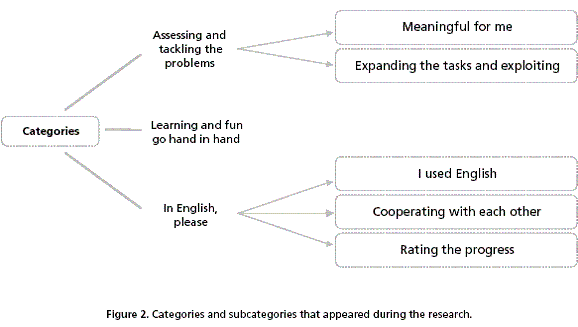
Using the questionnaires, interviews and comments in the different classes allowed me to reflect upon the different problems students experienced. First, a print interview was handed out in order to learn their views. The focus was on a specific question developed in the Interview: What aspects of English pronunciation are the most difficult in your opinion? This was an open question. Students expressed that the most difficult aspects were unknown vocabulary, linked sounds, contractions, minimal pairs and other aspects such as intonation. The results during the 5 sessions were the following:

Meaningful to me
One of the main results that appeared in the interviews developed before every karaoke activity was related to the differentiation consonants or vowels sounds (minimal pairs). For example, why is the same letter pronounced differently in different sets of words? We know the pronunciation of the phoneme “i” changes so frequently that it is difficult for us to know the correct pronunciation. For the records, during the first interview, the students’ main concern was how to pronounce words they did not know; for this reason, I had to include vocabulary tasks within the first activity to later explain their meaning and their pronunciation
Taking into account students’ needs, I was able to get them interested in the activities of karaoke; also, I was able to establish some meaning for them regarding how karaoke and singing can provide great benefits. In the other activities, students were more concerned about minimal pairs. A few students did not know to what extent the differences in the vowel pronunciation could alter the total meaning of a word; thus, they became more enthusiastic about learning these kinds of differences.
In an interview carried out in Spanish after one karaoke session, one student says1:
Interviewer: We’re here with Armando Perez, student of Praxis. Tell us what you think about this karaoke experience?
Armando Pérez: The karaoke experience was good due to the fact that writing is different from pronouncing. We tend to confuse certain words when we speak, and this helps us make clear many facts, and also helps us clarify many aspects of pronunciation, and sounds we make when we speak.
The interview above evidenced the worry that students shared in all our classes: the disparity between writing and pronouncing, one of the main challenges we face when we study English. This sub-category was important in order to analyze the main interests of students in the pronunciation area.
Expanding tasks and exploiting
In this subcategory, students and teachers studied other real life examples of the previous activities: their expected and unexpected findings about where and when they could find these kinds of pronunciation tasks in a conversation, or in a book or lesson, etc. Also, it was possible to find out how we could integrate the contents of a song with the contents of the activities.
The tasks were important in order to establish a feeling of achievement among students; it could be observed that activities should not have a short-term impact, but a lasting one. Hence, to test students’ pronunciation, practice and discussion were put into the activities as a way to measure students’ improvement. Many of the tasks consisted of finding similar words that had the same/similar pattern of pronunciation or just making some kind of conversation and doing a more involved reading of the lyrics after having sung the song. Students were able to find real life contexts where they could use the phonetics previously studied. In my diary I gathered that students often collected words that applied to the phonetic patterns using their textbooks, words they knew but that did not appear in the karaoke activity. They were able to converse fairly well as well as recognize how minimal pairs worked. Other students, by hearing other conversations, could observe how minimal pairs worked in a real life context such as a conversation.
For instance, in the activity number 4 (song: “Bohemian Rhapsody” by Queen), students were supposed to find words with phonemes given in the activities; later they had to match the teacher’s pronunciation to finally make up a rule.
Sample activity 1. Pronunciation practice.
1) The teacher will pronounce one of the two words. Select the right one.
[0] Thank tank
Both boat
Thin sin
Bath bat
Thick sick
2) Select the right word according to the teacher’s pronunciation.
[ð ]
they day
breathe breed
there dare
than Dan
Learning and Fun Go Hand in Hand
In this category, I intended to describe students’ thoughts about the karaoke activities before, during and after implementation. I also contemplated promoting students’ participation and learning by bringing in exciting activities that led the students along a more efficient path of learning. This category also dealt with students’ feelings and strove to depict how much they enjoyed the activity in conjunction with how much they think they learnt.
As I said during the description of the student population, many of them work or study full time; their English classes were an important complement to their life but not the main component. It is essential to note that some of them expected karaoke to be only singing, to have a good time on the sofa and wait for the brave student to sing in front of the class. Others expected karaoke to perhaps be the opportunity to sing their favorite song and prove that they had a good voice.
The different misconceptions about karaoke activity result from the Institution’s never having put into practice this kind of karaoke activities related to aspects of the English language. Another aspect was that students had gone to karaoke bars singing songs in Spanish and relating this activity with heavy drinking and dancing. During the interviews, I received these kinds of comments:
• Karaoke is singing and listening to favorite songs. I hope they play the songs that I like.
• With karaoke, we can get to know each other. I don’t know many people so I want to see who is attending.
• I’d like to sing any song, I consider myself to have a good voice.
• I want to see what the songs are about, the lyrics, and to join.
In English, Please
This category intended to account for the degree students used English in the activity, their struggles as well as how well they coped with the different tasks and finally to rate their progress regarding pronunciation after the karaoke activities. This category was divided into the following three sub-categories: I used English, Cooperating with each other and Rating the progress.
I used English
In this subcategory, the main benefits of creating an environment in which English could be used to the maximum extent were studied. generates an atmosphere to promote students’ use of English in class as well as identification of the problems they had related to the activities. One of my concerns was if students really could use English all or most of the time during the karaoke activities. This was also useful for checking their advancement in pronunciation and their understanding of the tasks.
According to the video transcripts, I realized that students were able to identify the purpose of the tasks; they used English mostly when interacting with the instructor and when they had to ask questions. Unfortunately, Spanish was mostly the choice when they worked with a partner or their last resource to check understanding.
Extracts from the video transcripts showed me that the students who sat down in the front of the class were also the students who used English most of the time in contrast with the ones sitting in the back. Another good opportunity to check their English usage was when students asked questions, for instance:
Vannessa Pérez: Teacher, what is the meaning of “baby, light my fire”. I do not understand.
Alexandra Sanabria: I did not know about different pronunciations of [i]; in Spanish we only have one.
The conclusion was that karaoke was a good strategy not only to improve pronunciation, but also to promote the use of English in the classroom. Thanks to this, the students had a meaningful time in which they could learn and practice the language.
Cooperating with each other
One of the strategies that I wanted to enhance during the activities concerned cooperating with each other. By doing so the intention was to answer one of the questions related to what students’ reactions towards the activities were and the social behavior they reflected, which is important in recreating a good environment for learning English.
As singing in front of a class or group could be a threatening situation for many of the participants, some were naturally shy and did not enjoy participating. Others were afraid of looking silly in front of the class. That was why I chose activities and tasks which involved student cooperation. Lightbown & Spada (1999) explained that Cooperative learning activities had been found to increase the self-confidence of students, including weaker ones, because every participant in a co-operative task had an important role to play. For instance, I collected this dialogue in Spanish; two students were working together trying to solve a task. This dialogue caught my attention:
Jorge: Help me complete this exercise, what option did you choose?
Narda: I put the first one, you see it sounds different to the others.
Jorge: True, we learn a lot with these activities.
Narda: That is why I always try to attend.
Karaoke activities proved to be a very good way to integrate people, to get them to work together and achieve good results in self-esteem, as many showed that they were capable of doing something previously unthinkable in front of the class such as singing, answering questions and so forth.
Rating the progress
One of the main questions dealt with the effectiveness of karaoke to improve pronunciation. First to establish the fact that karaoke was fun, to create multiple activities and to get people to work together, I needed to research if karaoke was truly effective for improving students’ skills at pronunciation. To analyze this activity I used two techniques: one was a verbal technique in which students had to speak in front of the class, repeating and reading the sentences and also participating in open communication in the normal classes. The other one was based on the activities after singing the song and explaining the facts.
First, thanks to the video and the diary, I could keep a record of their progress. Many students, class after class improved their pronunciation by recognizing the different phonemes and their variations, learnt how to identify word, tasks and so forth, and with these activities I could tabulate their progress or their failure concerning the karaoke activities. For instance, after listening to the song “One” by Metallica, we performed a little test. The objective was to circle the word that was not pronounced with the phonemes [au]. The results were as follows:

It was the first time they had this kind of exercise. They did not know many words, but could recognize some patterns explained in the song and in the exercise. For an exercise with 10 questions, the results were outstanding. They also mentioned that they had advanced a lot during these exercises. Their answers to the next question also showed the degree of conformity for the karaoke activities.
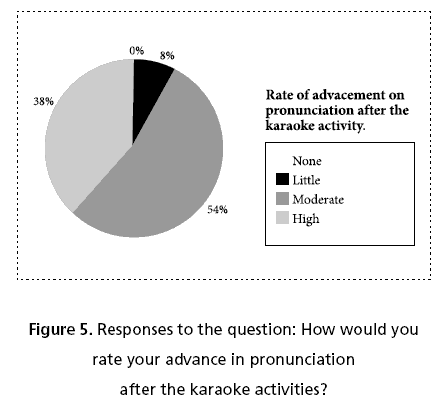
This was during the first class and during the last class. These were the results to the same question.
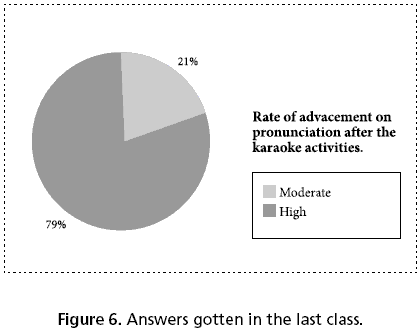
The results were outstanding. Most of the student stated that they had learnt a lot from the activities; also they stated that the karaoke activities were clear, important and vital to this progress. On the test, they did pretty well. The majority understood the basics, the phonemes and how the same phonemes can be pronounced differently. During the tests, no student had fewer than 6 questions correct out of 10. During the discussions, speaking activities, their pronunciation advanced greatly.
Conclusions
Taking into account the research question proposed for this project and based on all the information collected, it could be concluded that karaoke activities promoted learning in a laidback environment. Karaoke, by itself, could be monotonous and a quick plan to have fun; but complemented with activities and tasks, karaoke itself could be the leading point to bring more original activities into the classroom without neglecting communicative, intellectual and social factors. Therefore, activities could be implemented into a serious and responsible syllabus. Karaoke activities, then, could be and must be taken seriously. They were challenging for both students and teachers, not only because we needed to sing, but especially because teachers needed to prepare tasks and activities that were meaningful and related to the song and, at the same time, create a good atmosphere to accomplish these same tasks.
Students at the same instance were required to ponder the effectiveness of the activities. For purposes of these studies, students were eager to know about the activities more than the song itself after a series of sessions as, step by step, they discovered that the activities brought a lot of knowledge and good practice to enhance their pronunciation, independent of their musical tastes.
The karaoke activities were and should be pertinent to the learning of English. In this project, pronunciation was the skill I focused on. Teachers could implement lots of exercises from books or invent their own exercises, and using and exploiting these exercises with the purpose of singing could be more effective than using the books or exercises alone.
One of the goals was that students and teachers use English most of the time that they interacted, responded and solved the exercises using the target language to learn. Karaoke itself provided a lot of motivation to students to try to imitate the sounds and specially to find a relaxed atmosphere where they could use their English without fear of being criticized. Feelings of selfachievement were so high that many students felt very comfortable speaking English even though they had limitations. It is important to conclude that karaoke brought tons of motivation into the class; nobody felt threatened or discouraged. Comprehension and production on the part of the students were greatly positive and, for the results of this study, most of the students who attended the sessions enhanced their pronunciation notably.
Another aspect that was established in the objectives was to prepare a common ground to study students’ feelings and their responses towards the karaoke activities. The main result was that feelings of inhibition, fear or discouragement were totally eliminated. Fortunately, thanks to the karaoke, students followed most of the “ten commandments” for good learning proposed by Brown (2000) such as: Lower inhibitions, encourage risk taking, develop intrinsic motivation, engage in cooperative learning, promote tolerance, among others.
It was very important to take into account that the karaoke was used primarily to enhance students’ pronunciation and to be able to design, re-design, and adapt activities that could be integrated to the songs or to complement the karaoke songs. English phonetics and phonology are subjects that need discretion to be taught. My intention in this study was to show the basics and to help solve more doubts and uncertainties students have. The limitations come to my mind are the cases where I could not integrate more profound elements such as tone, pitch or risefall intonation. Another intention was to be able to prepare students to distinguish the basics, to be able to immerse them in an appropriate but familiar way in the world of phonetics and phonology. For further research, I would like to integrate aspects such as those named above using the karaoke. Let us remember that karaoke can also be used to read texts.
1 Data collected in Spanish. Translations belong to the author. The participants’ names have been changed.
References
Brown, D. (2000). Principles of language learning and teaching (4th Edition). White Plains, NY: Longman.
Brown, J. (2001). Using surveys in language programs. Cambridge: Cambridge University Press.
Burns, A. (1999). Collaborative action research for English language teachers. Cambridge: Cambridge University Press.
Dale, P., & Poms, L. (1986). English pronunciation for Spanish speakers. Englewood Cliffs, New Jersey: Prentice Hall Regents.
Davies, P., & Pearse, E. (2000). Success in English teaching. Oxford: Oxford University Press.
Giles, H. (n.d.). Personal quotes. Retrieved on March 3, 2009 from http://www.giga-usa.com/quotes/authors/henry_giles_a001.htm
Hopkins, D. (1993). A teacher’s guide to classroom research. London: Open University Press.
Kemmis, S., & McTaggart, R. (1982).The action research planner (2nd Edition). Waurn Ponds, VIC: Deakin University School of Education.
Lightbown, P., & Spada, N. (1999). How languages are learned. Oxford: Oxford University Press.
McDonough, J., & McDonough, S. (1997). Research methods for English language teachers. New York: St. Martin’s Press, Inc.
Murphey, T. (1992). Music & song. Oxford: Oxford University Press.
Stern, H. (1992). Issues and options and language teaching. Oxford: Oxford University Press.
Wong, R. (1993). Pronunciation myths and facts. Forum, 31, (October), 45-46.
References
Brown, D. (2000). Principles of language learning and teaching (4th Edition). White Plains, NY: Longman.
Brown, J. (2001). Using surveys in language programs. Cambridge: Cambridge University Press.
Burns, A. (1999). Collaborative action research for English language teachers. Cambridge: Cambridge University Press.
Dale, P., & Poms, L. (1986). English pronunciation for Spanish speakers. Englewood Cliffs, New Jersey: Prentice Hall Regents.
Davies, P., & Pearse, E. (2000). Success in English teaching. Oxford: Oxford University Press.
Giles, H. (n.d.). Personal quotes. Retrieved on March 3, 2009 from http://www.giga-usa.com/quotes/authors/henry_giles_a001.htm
Hopkins, D. (1993). A teacher’s guide to classroom research. London: Open University Press.
Kemmis, S., & McTaggart, R. (1982).The action research planner (2nd Edition). Waurn Ponds, VIC: Deakin University School of Education.
Lightbown, P., & Spada, N. (1999). How languages are learned. Oxford: Oxford University Press.
McDonough, J., & McDonough, S. (1997). Research methods for English language teachers. New York: St. Martin’s Press, Inc.
Murphey, T. (1992). Music & song. Oxford: Oxford University Press.
Stern, H. (1992). Issues and options and language teaching. Oxford: Oxford University Press.
Wong, R. (1993). Pronunciation myths and facts. Forum, 31, (October), 45-46.
How to Cite
APA
ACM
ACS
ABNT
Chicago
Harvard
IEEE
MLA
Turabian
Vancouver
Download Citation
Article abstract page views
Downloads
License
Copyright (c) 2009 Andrés Roberto Rengifo

This work is licensed under a Creative Commons Attribution-NonCommercial-NoDerivatives 4.0 International License.
You are authorized to copy and redistribute the material in any medium or format as long as you give appropriate credit to the authors of the articles and to Profile: Issues in Teachers' Professional Development as original source of publication. The use of the material for commercial purposes is not allowed. If you remix, transform, or build upon the material, you may not distribute the modified material.
Authors retain the intellectual property of their manuscripts with the following restriction: first publication is granted to Profile: Issues in Teachers' Professional Development.





